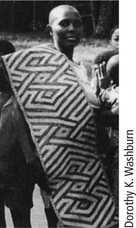Skills Check
![]() Skills Check
Skills Check
Question 19.1
1. Symmetry includes notions of
- balance.
- similarity.
- repetition.
- all of the above.
1.
d
Question 19.2
2. Many people think that mathematics is just about numbers, but in fact mathematics includes the study of _________________.
2.
patterns
Question 19.3
3. Which of the following rectangles is closest to the aspect ratio of a golden rectangle?
- 16 by 9
- 13 by 6
- 11 by 8
3.
a
Question 19.4
4. The geometric mean of 4 and 36 is _____________.
4.
12
Question 19.5
5. Which artist claimed to use the golden ratio in his work?
- Leonardo da Vinci
- Wolfgang Amadeus Mozart
- Neither
5.
c
Question 19.6
6. In the Fibonacci sequence, _________ is the next element after 21.
6.
34
Question 19.7
7. Recursion means
- cursing over and over.
- giving a next number in terms of previous ones.
- giving previous numbers in terms of the current one.
7.
b
Question 19.8
8. Of pineapples, pine beetles, and pine bark, only ___________ exhibit Fibonacci numbers.
8.
pineapples
Question 19.9
9. Phyllotaxis is
- the town in Pennsylvania where fractals were invented, near Fillodoughphia.
- more taxis than you need.
- a spiral pattern in plants.
9.
c
Question 19.10
10. The geometric mean of 4, 16, and 125 is ____________.
10.
20
Question 19.11
11. A rigid motion always moves any pair of points
- in the same direction.
- to another pair of points the same distance apart.
- to their mirror images.
11.
b
Question 19.12
12. The capital letters ______, ______, ______, ______, ______, ______, and ______ each have a rotation isometry.
12.
H; I; N; O; S; X; Z
Question 19.13
13. Assume that the following two patterns continue in both directions. Which of these patterns has a reflection isometry?
ZZZZZZZZZUUUUUUUUU
- ZZZZZZZZZ only
- UUUUUUUUU only
- Neither
13.
b
Question 19.14
14. This strip pattern
⌟⌜ ⌟⌜ ⌟⌜ ⌟⌜ has _________ and _________ isometries.
14.
translation; rotation
Question 19.15
15. What isometries does this wallpaper pattern have?

- Translation and reflection only
- Translation and rotation only
- Translation, rotation, and reflection
15.
c
Question 19.16
16. This wallpaper pattern
has ________ and ________ isometries.

16.
translation; reflection (along diagonal lines)
Question 19.17
17. If a horizontal strip pattern has a glide reflection isometry, then
- it always has a horizontal reflection isometry.
- it may also have a horizontal reflection isometry.
- it cannot have a horizontal reflection isometry.
17.
b
Question 19.18
18. If a strip pattern has both vertical and horizontal reflection isometries, then it always has a ___________ isometry.
18.
half-turn rotation
Question 19.19
19. Consider the strip pattern in the raffia cloth held by the woman in the photo at right. What isometries does it have?

- Vertical reflection
- Horizontal reflection
- Glide reflection
19.
c
Question 19.20
20. There are _____ ways to repeat a pattern along a strip.
20.
7
Question 19.21
21. The key mathematical idea for detecting and analyzing patterns is
- cataloging possible motifs.
- figuring out the symmetries.
- looking for the golden ratio.
21.
b
Question 19.22
22. The symbol p indicates that a strip pattern has ____________ symmetry.
22.
translation
Question 19.23
23. The symbol 2 indicates that a pattern has
- rotational symmetry.
- reflection symmetry.
- too much symmetry.
23.
a
Question 19.24
24. The symbol m indicates that a wallpaper pattern has _____________________ symmetry.
24.
reflection
Question 19.25
25. The symmetry group of a nonsquare rectangle has how many elements?
- 4
- 6
- 8
25.
a
Question 19.26
26. The symmetry group of the strip pattern pmm2 has ___________ elements.
26.
infinitely many
Question 19.27
27. The symmetry group of a square has how many elements?
- 2
- 4
- 8
27.
c
Question 19.28
28. In the mattress group, the result of a flip followed by a rotation is a _______________.
28.
toss
Question 19.29
29. In mathematics, chaos refers to
- randomness.
- disorder.
- unpredictability.
29.
c
Question 19.30
30. A fractal is a pattern that exhibits ____________ at ever finer scales.
30.
self-similarity